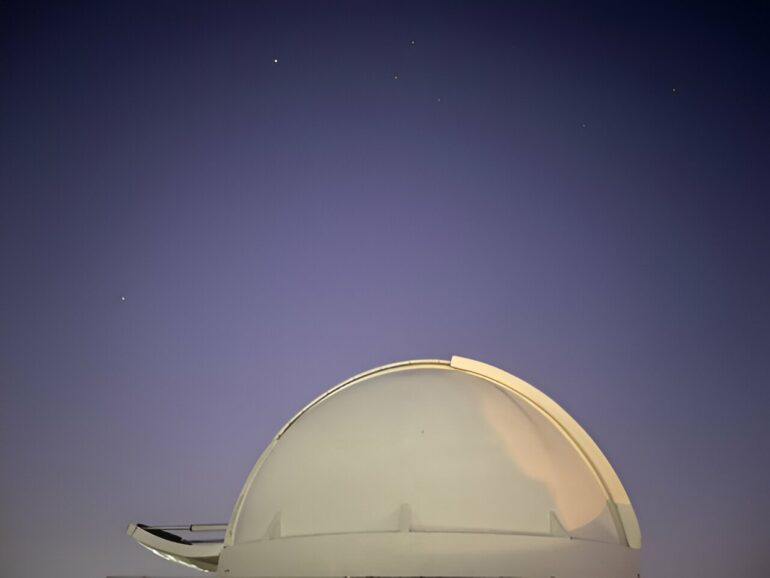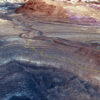It can be tempting to think of the stars that light up the sky each night as timeless. Astronomy professor John Thorstensen knows better. He has spent the last four decades studying cataclysmic binary stars, a pair of stars circling each other in close range: a smoldering dead star known as a white dwarf, and a star like our sun, in the prime of its life, that’s been pulled into the dead star’s orbit.
The white dwarf gradually siphons off hot gas from its companion, forming a ring that can flare at random intervals. To an observer on the ground, the two appear as one, growing brighter and dimmer with time.
“It’s a reminder that stars have life cycles and evolve over time,” Thorstensen says. “Not even the stars are eternal.”
Amateur astronomers like cataclysmic binaries, also known as cataclysmic variable stars, or CVs for short, because their intermittent eruptions are bright enough to be seen with a basic telescope. Their intensity is the main reason Thorstensen made CVs his life’s work upon coming to Dartmouth in 1980. More than 10,000 have been counted so far but only a fraction have been described in any detail.
Today, astronomers have worked out the orbital periods of about a thousand CVs. The orbital period—typically a few hours—reveals roughly how close the two stars are, and where they are in their evolution. Over his career, Thorstensen has discovered several cataclysmics of his own and characterized hundreds more, including 30 ‘short-period’ CVs in a 2020 survey.
In recent years, undergraduates have joined Thorstensen on his hunt through the Astronomy Foreign Study Program. Students spend winter term at University of Cape Town, taking classes from Dartmouth astronomy professors and immersing themselves in South African culture. The highlight is a one-week visit to the South African Astronomical Observatory in Sutherland, a remote location four hours north of Cape Town. Student travel to and from the observatory and accommodations were underwritten by a generous donation from Claudia and Jay Weed.
In one of the most productive visits yet, Thorstensen and four students returned this spring with new details on seven cataclysmics, about 1,000 to 3,000 light years from Earth. Their observations have been published in The Astronomical Journal.
Discovering South Africa’s dazzling night sky
At the far tip of Africa, bordered by the turbulent Southern Ocean, South Africa is known for its stunning and often remote landscapes. It’s perhaps less known for its star-studded sky. The national observatory sits on a desert plateau, home to the largest optical telescope in the Southern Hemisphere and many smaller instruments.
On the drive there, the settlements grow farther and farther apart. Once the sun sets, the absence of light is striking. Each evening, the students would set out from the dormitory with their “night lunches.” After a mile-long hike, they would reach the observatory, turn on the equipment, and wait.
“Once the sun goes down, it’s so dark you can’t see your hands,” says Chase Alvarado-Anderson ’23, an astronomy major from Dallas. “Then your eyes adjust, and it immediately clicks. The sky looks like a black canvas splattered with white paint.”
Abigail Burrows, a fellow astronomy major from Washington, D.C., was similarly dazzled. “As you grow accustomed to the dark, the sky explodes before your eyes,” she says. “Every time you look back at a spot you see more and more stars. We saw the Southern Cross, the large and small Magellanic Clouds, and in the earliest part of the morning, the Galactic plane.”
COVID-19 delayed the trip by two years. By the time senior year arrived, neither student was sure they would get to go. Alvarado-Anderson had been to MDM Observatory on Kitt Peak, near Tucson, which Dartmouth operates as part of a consortium of schools. Burrows had never been farther than Europe. This winter, the stars aligned. This past February, having long finished their prerequisites, they flew to Cape Town.
Thorstensen was also ready. From a catalog of 10,000 targets, he had selected CVs that appeared to be relatively bright, little known, and could be observed with relatively modest equipment. The 1940s telescope they used in the study had a 1.9-meter mirror, tiny compared to the observatory’s famous SALT telescope. But it still had enough power to gather the measurements they needed.
Mounted on the telescope as a spectrograph, an instrument that divides the light into its different colors, or wavelengths, much as a prism splits white light into a rainbow. The amount of light present at each wavelength tells you what a star is made of. All stars contain hydrogen, which shines a deep red when its alpha spectral line emission is observed, and it’s this element that allows you to measure their speed. When a star moves away from the observer, its light gets stretched out to longer, redder wavelengths; when it moves toward the observer, its wavelengths shorten and shift toward blue.
The faster the star, the greater the shift in wavelength, due to the Doppler effect, the phenomenon that causes the pitch of a siren to drop as an ambulance or fire truck moves away from you. By measuring the changing wavelengths of their target CVs, the students were able to clock their speeds which, in turn, allowed them to calculate their orbital periods.
All seven of their cataclysmics, they found, were typical, circling each other in periods of a few hours, typically traveling more than 100 miles per second. Four of the stars they studied were persistently bright, in a class known as nova-like variables, while the others were dwarf novae with small outbursts.
“These systems share similar physics, but depending on what type of secondary star you have, they can appear very different,” Burrows says.
Each measurement could take hours. If the humidity got too high, the students had to shut down the telescope.
Alvarado-Anderson came away from the trip with his first published paper, proficiency with astronomy programs like IRAF, PyRAF, and ds9, and advice on how to pass the qualifying exam for grad school. Now headed to Stanford for a Ph.D. in planetary science, Alvarado-Anderson says the trip reaffirmed his love of space and the stars.
It also changed his perception of the white dwarfs at the heart of all CVs. Before, he saw the dense core of a dead star that had run out of fuel. Today, he sees a star that, by siphoning off gas from its neighbor, has come back to life.
“It’s so interesting to think of the process as a rebirth,” he says.
More information:
John R. Thorstensen et al, Optical Studies of Seven Bright Southern Cataclysmic Variable Stars, The Astronomical Journal (2023). DOI: 10.3847/1538-3881/ace7bf
Citation:
New details revealed about the life cycle of an unusual class of stars (2023, September 6)



